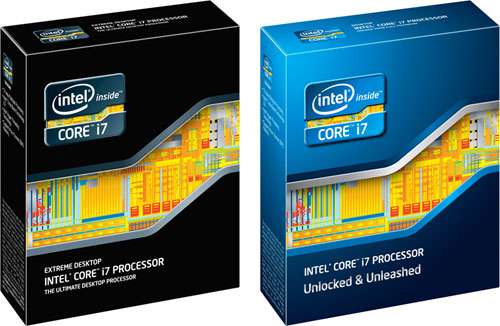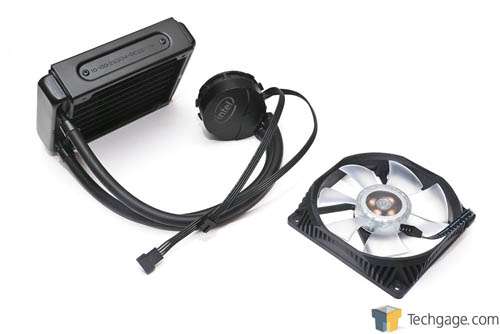- Qualcomm Launches Snapdragon 4 Gen 2 Mobile Platform
- AMD Launches Ryzen PRO 7000 Series Mobile & Desktop Platform
- Intel Launches Sleek Single-Slot Arc Pro A60 Workstation Graphics Card
- NVIDIA Announces Latest Ada Lovelace Additions: GeForce RTX 4060 Ti & RTX 4060
- Maxon Redshift With AMD Radeon GPU Rendering Support Now Available
Intel Core i7-3960X Extreme Edition Review
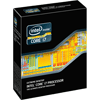
To those looking to build the biggest, baddest high-end PC around, the wait for Sandy Bridge-E was no doubt painful. But, it’s finally here, and much to our expectations, Intel has once again solidified its position as the performance leader. So let’s take a look at what it offers, and compare it to the i7-990X, i7-2600K and AMD FX-8150.
Page 1 – Introduction
With the launch of its Sandy Bridge microarchitecture earlier this year, Intel accomplished something unusual. It managed to deliver such a strong product, that it had effectively dampened the greatness that was the six-core Gulftown. That being the $999 Core i7-980X, of course.
It’s not unusual to see a new processor outperform an old one, but this was different. Intel didn’t launch Sandy Bridge with the intent of replacing its top-end offerings – proven by the fact that the most expensive chip at the time was the Core i7-2600K, at $317. Instead, it was the company’s goal to deliver the best budget to mainstream processors we’ve ever seen. As we discovered in our launch article, the company certainly managed that.
Here, we had the new hotness in one hand, and the lagging-behind six-core in the other. Sandy Bridge didn’t only offer a higher-performing architecture, it improved greatly upon power efficiency and at the same time packed in the AVX instruction set. There’s also the fact that in most tests, the i7-2600K didn’t even lag that far behind Intel’s beefier and much more expensive six-core offering.
With its Sandy Bridge-E launch however, all of this becomes moot. To create this “new” microarchitecture, Intel compiled the best of both worlds into a single offering. That means we have both the highly-efficient architecture of Sandy Bridge, along with the six-core likeness of Gulftown. Together, these ingredients produce the fastest desktop processor ever.
Sandy Bridge-E focuses entirely on the high-end of Intel’s desktop processor spectrum, and as such, it doesn’t supersede the original Sandy Bridge. Rather, it replaces Gulftown, and as that architecture stretches back to Nehalem which launched in the fall of 2008, you could say this upgrade is a little overdue.
Clock-for-clock, Intel claims that Sandy Bridge-E will be about 20% faster on average versus Gulftown. At the low-end, performance boosts could be around 10%, while at the high-end, gains of up to 50% are possible. Thanks entirely to the move to a quad-channel controller, memory bandwidth could see an improvement of up to 100% compared to a dual-channel controller and 50% compared to a triple-channel one.
We’ll discuss the Sandy Bridge-E architecture and X79 platform on the following page, so for the rest of this one, let’s take a look at specs, pricing and other fun facts.
|
Intel CPU
|
Cores
|
Threads
|
Clock
|
Turbo
|
Cache
|
GPU
|
TDP
|
1Ku Price
|
| Core i7-3960X (1) |
6
|
12
|
3.30GHz
|
3.90GHz
|
15MB
|
N/A
|
130W
|
$990
|
| Core i7-3930K (1) |
6
|
12
|
3.20GHz
|
3.80GHz
|
12MB
|
N/A
|
130W
|
$555
|
| Core i7-3820 (1) |
4
|
8
|
3.60GHz
|
3.90GHz
|
10MB
|
N/A
|
130W
|
$TBD
|
| Core i7-2700K (2) |
4
|
8
|
3.50GHz
|
3.90GHz
|
8MB
|
~1350MHz
|
95W
|
$332
|
| Core i7-2600K (2) |
4
|
8
|
3.40GHz
|
3.80GHz
|
8MB
|
~1350MHz
|
95W
|
$317
|
| Core i7-2600 (2) |
4
|
8
|
3.40GHz
|
3.80GHz
|
8MB
|
~1350MHz
|
95W
|
$294
|
Microarchitecture: (1) Sandy Bridge-E, (2) Sandy Bridge
|
At price-points sure to make the remaining AMD execs cringe, Intel is pricing its top-end Core i7-3960X Extreme Edition at $990, and the step-down Core i7-3960K at $555 (both per 1,000). The differences between them lies in the amount of L3 Cache they’re equipped with and also their clock speed. Both chips are fully unlocked, ready to be overclocked a little, a lot, or to a point that would make me cringe.
The Core i7-3820, a quad-core offering, will hit retail in early 2012. Like the others, it bumps up its L3 Cache compared to the previous generation, along with its clock speed. Interestingly, though its specs are comparable to the Core i7-2700K, its TDP will see a boost to 130W, from 95W.
I’m sure it’s obvious that moving from a socket with 1366 pins to one with 2011 would result in a much larger chip, but Sandy Bridge-E managed to surprise even me. This thing is huge.
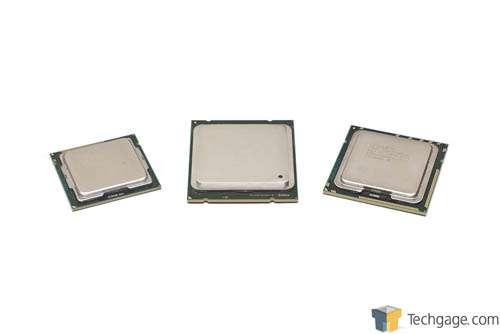 Left to Right: Intel Core i7-2600K, i7-3960X & i7-990X |
I don’t think that photo does this fact any justice. Instead, take a look at a simple graphic I made comparing the die sizes of all three Intel architectures we’ve been discussing here, and also AMD’s last-gen Thuban and current-gen Zambezi (Bulldozer):
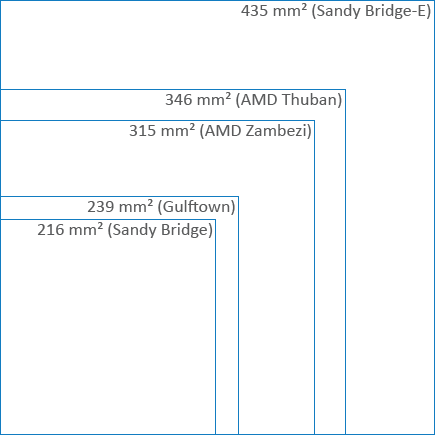
Sandy Bridge-E’s gigantic die is more than just a fun fact, though. Due to its size, there are four notches found around the chip’s perimeter to better situate it in its socket. The LGA2011 socket itself also uses two latching arms in lieu of one, effectively strapping the CPU in as if it’s about to receive lethal injection. It’s a serious setup for a serious processor.
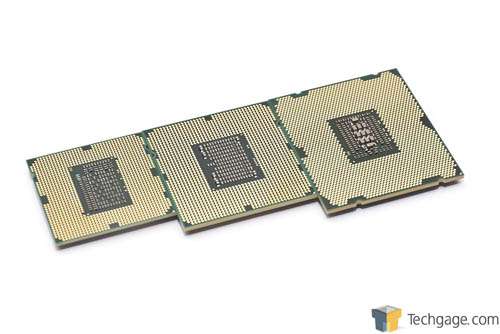 Left to Right: Intel Core i7-2600K, i7-990X & i7-3960X |
As has been rumored for the past couple of months, Intel is not including a CPU cooler with any of its Sandy Bridge-E processors. As almost no one shelling out their hard-earned money for a high-end processor will ever use the included cooler, Intel’s decision on this is reasonable.
Knowing that some people would still prefer an official Intel offering, the company has teamed up with Asetek to produce an all-in-one liquid cooler it can call its own. The pump is similar in design to that on Corsair’s H60, though the radiator is as thick as the one found on the H80. Overall, that means it should be quite an outstanding performer – though it’s sure to be priced like one.
Our CPU test machine already has a Corsair H80 installed, so we opted to use that instead of Intel’s own offering. We may test this solution in the near-future, however, if time allows.
We’ll take a look at the Sandy Bridge-E architecture on the following page, as well as the X79 Express chipset. If you’re more interested in jumping straight into the results, hit up page 4.
Support our efforts! With ad revenue at an all-time low for written websites, we're relying more than ever on reader support to help us continue putting so much effort into this type of content. You can support us by becoming a Patron, or by using our Amazon shopping affiliate links listed through our articles. Thanks for your support!




